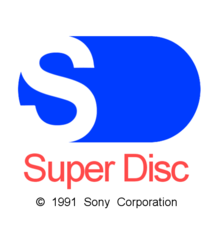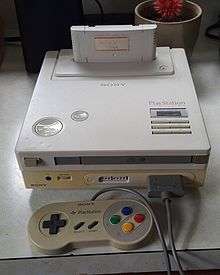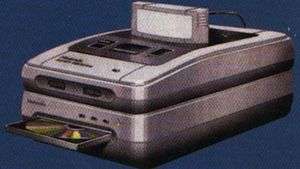Super NES CD-ROM
|
SNES-CD add-on prototype concept art | |
| Also known as | SNES-CD, Super Disc |
|---|---|
| Manufacturer | Nintendo, Sony |
| Type | Video game console add-on |
| Generation | Fourth generation |
| Release date | Unreleased |
| Media | CD-ROM, ROM cartridge |
The Super NES CD-ROM System[1][2] (also known as SNES-CD or Super Disc[3][4]) refers to an unreleased video game media format and peripheral for the Super Nintendo Entertainment System (SNES). The device and the format were to build upon the functionality of the cartridge-based SNES by adding support for higher capacity compact discs.
The SNES-CD platform was developed in a partnership between Nintendo and Sony. The platform was planned to be launched as an add-on for the standard Super NES, as well as a stand-alone hybrid console by Sony called the Play Station (spelled as two words). Another partnership with Philips yielded some poorly received Nintendo-themed games for the CD-i platform instead of the SNES-CD. Sony independently furthered its developments into its own console, which evolved into the original PlayStation, a chief competitor of the Super NES's cartridge-based successor, the Nintendo 64.
History
The relationship between Sony and Nintendo started when Sony engineer Ken Kutaragi became interested in working with video games after seeing his daughter play games on Nintendo's Famicom video game console. He took on a contract at Sony for developing hardware that would drive the audio subsystem of Nintendo's next console, the Super NES. Kutaragi secretly developed the chip, known as the Sony SPC 700. As Sony was uninterested in the video game business, most of his superiors did not approve of the project, but Kutaragi found support in Sony executive Norio Ohga and the project was allowed to continue. The success of the project spurred Nintendo to enter into a partnership with Sony to develop both a CD-ROM add-on for the Super NES and a Sony-branded console that would play both SNES games, as well as titles released for the new SNES-CD format.[5]
Development of the format started in 1988, when Nintendo signed a contract with Sony to produce a CD-ROM add-on for the SNES. After several years of development, Sony introduced a standalone console at 1991's summer Consumer Electronics Show called the "Play Station." The system was to be compatible with existing SNES titles as well as titles released for the SNES-CD format. However, due to licensing disagreements with Sony, Nintendo announced that it had formed an alliance with Sony's rival Philips to produce the SNES-CD add-on.[6][7]

However, the two companies conflicted over control of the licensing. Under their agreement, Sony would develop and retain control over the SNES-CD disc format, with Nintendo thus effectively ceding a large amount of control of software licensing to Sony. To counter this, Nintendo president Hiroshi Yamauchi sent Nintendo of America president Minoru Arakawa and executive Howard Lincoln to Europe to negotiate a more favorable contract with Philips, Sony's industry rival. At the June 1991 Consumer Electronics Show, Sony announced its SNES-compatible cartridge/CD console, the "Play Station". The next day, Nintendo revealed its partnership with Philips at the show—a surprise to the entire audience, including Sony.[7]
While Nintendo and Sony attempted to sort out their differences, approximately two hundred prototypes of the Play Station had been created in various physical forms,[8] and software for the system was being developed. In 1992, a deal was reached allowing Sony to produce SNES-compatible hardware, with Nintendo retaining control and profit over the games, but the two organizations never repaired the rift between them. By the next year, Sony had refocused its efforts on developing its own console for the next generation of consoles.[5][9]

In November 2015, it was reported that one of the original Nintendo PlayStation prototypes had been found. The prototype was reportedly left behind by former Sony Interactive Entertainment CEO Ólafur Jóhann Ólafsson during his time at Advanta.[10] A former Advanta worker (Terry Diebold) acquired the device as part of a lot during Advanta's 2009 bankruptcy auction. The system was later confirmed as operational and the unit plays Super Famicom cartridges as well the test cartridge that accompanied the unit, although the audio output and CD drive were non-functional.[4] In March 2016, retro-gaming website RetroCollect reported that they (and influential members of online emulation communities) had received (from an anonymous source) the functional disc boot ROM for the SNES-CD.[11][12]
In July 2016, a fan-game titled Super Boss Gaiden was developed for the add-on.[13] Later that month YouTube channel "The Ben Heck Show", featuring Benjamin Heckendorn, filmed a teardown of the device and repaired the CD-ROM drive and audio output.[14]
Specs
In July 2016, Benjamin Heckendorn documented a teardown of the only known prototype of the SNES-CD and published the specs of the console.[15] The standalone unit has the following connectors: Two SNES Gamepad ports, Cartridge slot, Dual-speed CD-ROM, AV RCA composite Stereo, S-Video, RFU DC OUT (similar to the PlayStation SCPH-1001), Nintendo proprietary Multi-out AV Connector (same as the Super NES, Nintendo 64, and GameCube), Headphone jack on the front, Serial Port labelled "NEXT" (probably for debugging) and one Expansion Port under the unit. According to Ben Heckendorn the system would probably be as powerful as a standard Super NES, but not as powerful as the Sega CD.[16]
| SYSTEM | PC Engine CD-ROM² | Mega CD | SNES-CD (SFX-100) |
|---|---|---|---|
| CPU (MHz) | 7.16 | 7.61 | 3.58 |
| Co-CPU (MHz) | None | 4 | 2.048 |
| Bus Width (Bits) | 8 | 16 | 8 |
| Add-on Processor (MHz) | None | 12.5 | None |
| Add-on Video | None | Present | None |
| Add-on Audio | CD | ASIC+CD | CD |
| CD-ROM Speed | 1x | 1x | 2x |
| Main RAM (KB) | 8 | 64 | 128 |
| Video RAM (KB) | 64 | 64 | 64 |
| Audio RAM (KB) | 0 | 8 | 64 |
| Exp RAM (KB) | 64 | 512 | 256 |
| Exp Video RAM (KB) | 0 | 256 | 0 |
| Exp Audio RAM (KB) | 64 | 64 | 0 |
| CD Cache RAM (KB) | 0 | 16 | 32 |
| Backup RAM (KB) for save data | 0 | 8 | 8 |
| Total RAM (KB) | 200 | 992 | 552 |
Legacy
After the original contract with Sony failed, Nintendo continued its partnership with Philips. This contract provisioned Philips with the right to use Nintendo's characters for a few games for its CD-i multimedia device, but never resulted in a CD-ROM add-on for the SNES.[9] Those Nintendo-themed CD-i games were very poorly received, and the CD-i itself is considered a commercial failure.[18] The main game in development for the SNES-CD platform launch was Squaresoft's Secret of Mana, whose planned content was cut down to the size suitable for cartridge and released on that medium instead.[19][20]
Ken Kutaragi and Sony continued to develop their own console and released the PlayStation in 1994. The CD-based console successfully competed with Nintendo's cartridge-based Nintendo 64. The broken partnership with Sony has been cited as an error on Nintendo's part, effectively creating a formidable rival in the video game market.[21][5] Nintendo would not release an optical disc based console until the release of the GameCube in 2001.[9]
See also
- TurboGrafx-CD, the CD-ROM add-on unit for the TurboGrafx-16, and the first attachment for playing CD-based games released for a dedicated game console
- Sega CD, a CD-ROM add-on unit released for the rival Genesis
- Nintendo 64DD, magnetic disc add-on released for the Nintendo 64
- Pioneer LaserActive, disc-based system compatible with the Genesis and TurboGrafx-16 through add-on units
References
- ↑ "Super NES Technology Update: CD-ROM". Nintendo Power. No. 35. April 1992. p. 70-71.
- ↑ "Super NES CD-ROM System documentation" (PDF). Nintendo of America, Inc. February 1, 1993.
- ↑ Theriault, Donald (July 3, 2015). "Nintendo Play Station Superdisc Discovered". Nintendo World Report. Retrieved November 6, 2015.
- 1 2 Lai, Richard (November 6, 2015). "We turned on the Nintendo PlayStation: It's real and it works". Engadget. AOL Inc.
- 1 2 3 Fahey, Rob (April 27, 2007). "Farewell, Father". Eurogamer.net. Retrieved March 8, 2012.
- ↑ Edge staff (April 24, 2009). "The Making Of: PlayStation". Edge. Future Publishing. Retrieved March 7, 2012.
- 1 2 IGN staff (August 27, 1998). "History of the PlayStation". IGN. Retrieved March 8, 2012.
- ↑ Lipshy, Jarrod S. "Why the Super Nintendo CD Would Have Been the Greatest Console Ever". Unrealitymag. Retrieved November 9, 2015.
- 1 2 3 Cowan, Danny (April 25, 2006). "CDi: The Ugly Duckling". 1UP.com. Retrieved March 8, 2012.
- ↑ Brian Crecente (July 3, 2015). "HOW MISFORTUNE AND A BIT OF LUCK LED TO THE DISCOVERY OF THE FABLED NINTENDO PLAY STATION". Polygon.com. Retrieved July 7, 2015.
- ↑ Buchanan, Adam (March 1, 2016). "Unreleased Super Nintendo CD "Nintendo PlayStation" Boot ROM Discovered". RetroCollect. RetroCollect.
- ↑ https://tcrf.net/Super_Disc_Boot_ROM
- ↑ http://www.nintendolife.com/news/2016/07/someone_has_actually_made_a_game_which_works_on_the_snes_playstation
- ↑ The Ben Heck Show (2016-07-22), Ben Heck's Nintendo-Playstation Prototype Part 2 Repair, retrieved 2016-07-23
- ↑ https://www.engadget.com/2016/07/16/nintendo-playstation-teardown/
- ↑ https://www.youtube.com/watch?v=ug-CyGXMabg
- ↑ https://www.youtube.com/watch?v=ug-CyGXMabg
- ↑ Blake Snow (May 4, 2007). "The 10 Worst-Selling Consoles of All Time". GamePro.com. Archived from the original on May 8, 2007. Retrieved November 25, 2007.
- ↑ Finnegan, Lizzy (April 7, 2015). "Secret of Mana: A Good Game With The Great Cut Out". The Escapist. Retrieved November 9, 2015.
- ↑ Schaulfelberger, Frederik (September 2006). "Sanningen om Mana". Level (in Swedish). IDG (6): 114–121.
- ↑ Nutt, Christian. "Birthday Memories: Sony PlayStation Turns 15". Gamasutra. Retrieved March 8, 2012.



